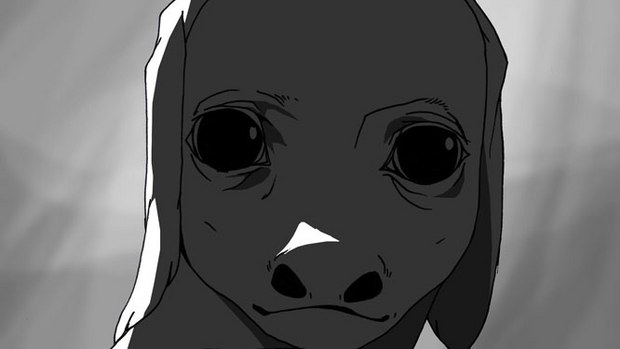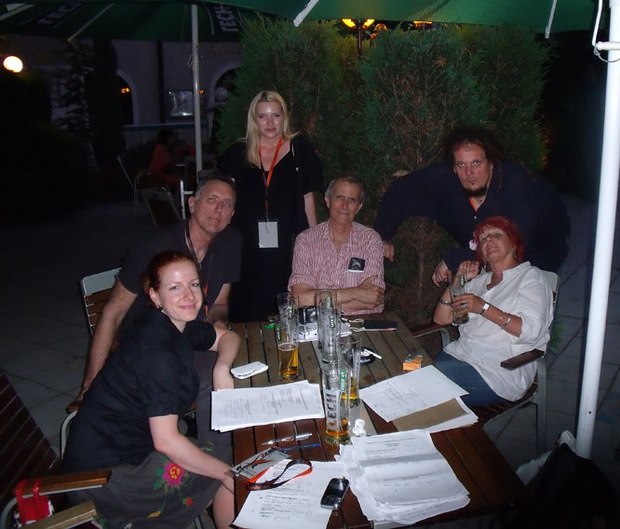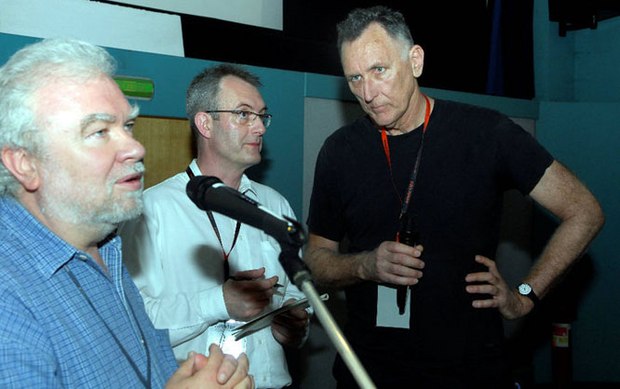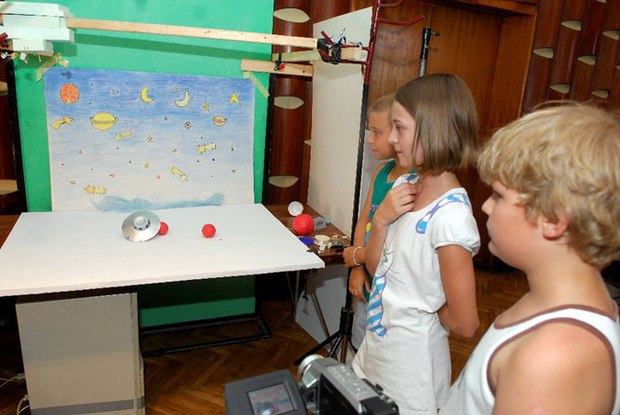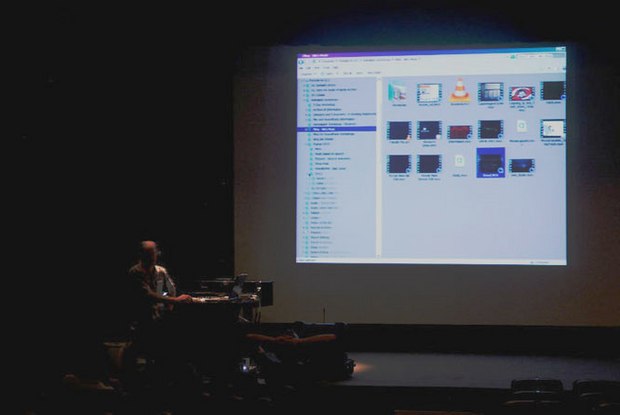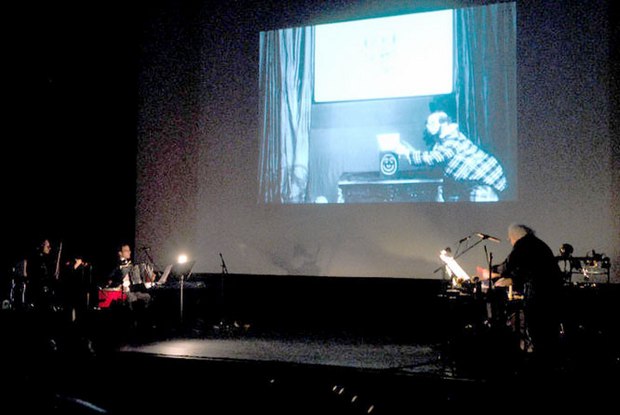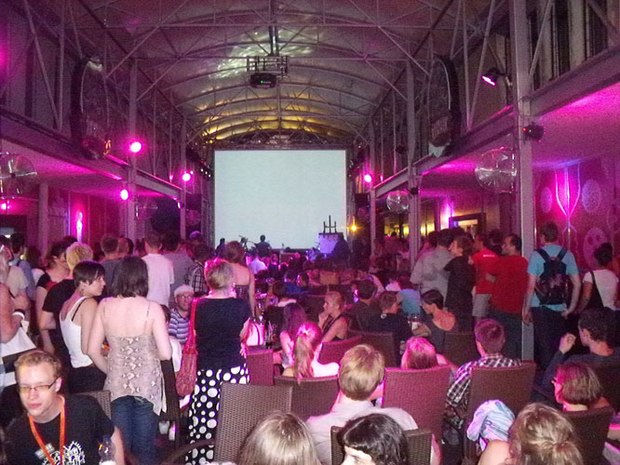Photos Courtesy Wojtek Wardejn, Animator Festival
When Nik and I were invited to ANIMATOR 3rd International Animated Film Festival, July 12 through 17th in Poznan, Poland, we were told that it was an animation and music festival. The description doesn’t do justice to the emphasis that the festival organizers place on the marriage of animation and music.
Along with two competition screenings each day and a myriad of special programs, every night there were screenings of animation with live music. There were also two screenings for young people each day and workshops for children of all ages. Because I had the privilege and honor to be on the jury, my days were fully taken up with watching the 82 films in competition and then with jury meetings.
One of my favorite films was My Grandmother Beijing by Norwegian animator Mats Grorud. The nine minute claymation tells the story of the modernization of Beijing as seen through the eyes of a young boy playing with his aged, wrinkly grandmother’s face. Grorud made the film while he was in Beijing studying at the China University of Communications as a commentary on the physical reconstruction of the city. Anyone who has been to Beijing is painfully aware of the destruction of the history of the city that is going on to make way for sterile high-rise building, alas, a plight not foreign to many other cities around the world.
I have admired Simone Massi’s work for a long time. Memories of Dogs won multiply awards and his new film Clouds,Hands has the same sense of silence and poetic austerity which draws the viewer’s attention to the significance of memory. Created in the look and feel of a woodcut , wooden baskets hanging from the tree branches evoke memories of his father, as a man and his dog wonder through the countryside. Simone creates a world where you smell the orange in the man’s hand and feel the gentle breeze blow the laundry that his mother is hanging out under a cloudy sky. Massi is a true master of pure, visual storytelling.
There was no separate category for graduation films, so student films were included in the regular competition. My favorite work by a student was I Am Simon. Tunde Molnar uses stark, sparse black and white to tell the story of Simon the dog as seen through Simon’s eyes. Being a dog person I watched the story of Simon and his canine and human companions with critical eye because I think trying to give voice and emotion to an animal is very difficult to do as a serious film. Tunde, a young Hungarian animator, captured what made me believe were the everyday true thoughts and feelings of a dog as close to reality as possible.
My fellow jury members were a diversely talented group. It was lovely to be with my old friend Dennis Tupicoff again. Dennis, a renowned Australian animator, is multi-talented but probably best known for his anima-doc His Mother’s Voice. The animated documentary is becoming increasing popular as a genre at festival and Dennis’ wonderfully poignant film of a mother relating the story of how she learned about her son’s death moves me no matter how many times I see it.
Brigitta Ivany-Bitter is a Hungarian animation historian. She curated the current exhibit at the Hungarian National Gallery of works by noted Hungarian animator and artist Gyorgy Kovasznai who worked during the ear of state socialism. She also wrote a lovely book to accompany the exhibition which also contains two DVD’s of Kovasznai’s work, along with a short documentary on his life. She presented each of her fellow jurors with a copy and I am enjoying reading it and learning a lot about Hungarian animation.
I was delighted to have the opportunity to get to know Mariusz Wilczynski. He is a Polish animator and performance artist with a great sense of humor which he displays equally in his work and in conversation. In 2007 Mariusz was given a retrospective by the Museum of Modern Art in New York City.
New Yorker George Griffin, our jury foreman, is no stranger to most independent animation lovers. George wears many hats as an animator, director, producer, critic, and lecturer. His work is essentially experimental and very personal.
Besides our jury duty we each presented a program. George introduced a retrospective screen of his films as well as a separate program titled Independent American Animation. His selection of films covered the entire spectrum of current animation from John Dilworth’s brilliant Life In Transition to the raw, handmade Triumph of the Wild from Martha Colburn. It was a nice surprise to see that he had included Eric Dyer’s Copenhagen Cycle which Nik created the sound track for. Eric is a master at blurring the lines between live-action and animation . In Copenhagen Cycles he feeds documentary footage of a bicycle ride around Copenhagen into a giant zoetrope and then video tapes it again through the zoetrope slots as it spins.
Dennis Tupicoff also screened seven of his films including his latest work, the multi-award winning Chainsaw. Dennis’s work are often had to watch, sometime verging on brutal like The Darra Dogs and Into the Dark but they always reward the effort by giving the viewer a great deal to think about.
I had never seen the films of Gyorgy Kovasznai until I watched the program of his short films presented by Brigitta Ivany-Bitter but I was captivated by the work of the legendary Hungarian painter and writer who turned to animation to thwart the Soviet ear censors. His work was dangerously outspoken for the times. On another evening his only feature length animation, Bubble Bath, was screened in the festival café. The film about a love triangle is a musical special-effects film set to the rhythm of a heartbeat.
My fellow juror Mariusz Wilczynski screened his animations to live music played by the Polish band Pogodno in the festival cafe. A performance artist as well as an animator, live music is an indispensable part of Marisuz’s screenings. Besides being visual delights, his films are very dreamlike while dealing with the complexities of life, emotions and dilemmas, As part of his presentation he drew on a large pad onstage as the band performed and his films screened.
Nik and I presented a program on the history and relationship of music and animation. In addition to screening the classic 1934 Hoppin and Gross film Joie de Vivre, which was the first animated film to have an original score, we screened ten other films and talked about the significance of each one.
The special programs wove a rich tapestry of international animation. To celebrate Daniel Szczechura’s 80th birthday and 50 years of artistic creativity six of his films were shown along with The Adventures of Daniel Szczechura, a portrait of the animator by Marcin Gizycki who is the Artistic Director of Animator. Szczechura is one of the most prominent representatives of Polish animation. Critics have nicknamed him “The Pope of Polish Animation”. Programs of films by Yuri Norstein and Caroline Leaf were shown along with a collection of films from the British Film Institute. Other screenings spanned the globe from contemporary Israeli Animation and a program of animation from Chicago, to a celebration of 30 years of short film production by The TV Studio of Animated Films in Poznan.
A new film from the Quay Brothers deserves attention and the premier of The Mask at Animator was no exception. The work of Stephen and Timothy has been heavily influenced by Polish literature, and their new film The Mask is an adaptation of a Stanislaw Lem story. Lem is a Polish science fiction writer best known as author of the novel which inspired Andrei Tarkovsky’s cult classic Solaris. The twin brothers say that this film is “unlike all other films we have made which chart the visual journey rather than a verbal, literary one. This one really shapes the images into a story that you really have to follow”.
The film focuses on the friction between the soul and the machine. An automation disguised as a beautiful woman is programmed to kill a prince who has turned against the king. As her consciousness grows she realizes her femininity and falls in love with her prey. Though programmed to kill, she also questions this programming. The Mask was shot at the largest castle in Poland, with a score composed by the renowned Polish classical composer Krzysztof Penderecki.
Each morning there were two separate Animator For Kids screenings. Azur & Asmar, Kirkou and the Sorceress, and Kirikou and the Wild Beasts, three of Michel Ocelot’s beautiful feature films, were screened. Michel was born in France but spent much of his childhood in Guinea. His early West African upbringing has a strong influence on his work, which has intricate animation and vivid colors. Although his films were listed as for young people they can be equally enjoyed by all ages.
A program of short French animation especially for the youngest audience showed a group of films, all under five minutes five in length. A special program of Polish fairy tales was accompanied by live music. Admission to all children’s programs and the short film competitions was free to the public.
There was also no admission fee for the workshops and lectures. Each morning there was a different 120 minute Animated Film Making workshop geared to 8 to 12 year olds. Topics ranged from puppet and stop-motion to a special workshop in cut-out animation given by Michel Ocelot.
For older students, Nik gave a five day workshop focusing on creating sound and music for animation. By the last day the students had composed two minutes of music for the classic Felix Woos Whoopie. The Toon Boom workshops tailored to beginners to acquaint them with Toon Boom software. The two day Fast Animation Workshops showed participants how to create short music videos for the internet.
Special lectures included “Personally Different – Creating Animation as an Adventure” given by Israeli animator Tsvika Oren. I found the “Smoke and Mirrors” presentation by New York independent media artist, freelance programmer, and magic lantern aficionado Artemis Willis to be most fascinating. Her demonstrations of the techniques used to create the intricate special effects of a bygone era of glass slide projection were both fascinating and instructive.
Nik and I presented a program on the history and relationship between music and animation. In addition to screening the classic 1934 Hoppin and Gross classic Joie de Vivre, which was the first animated film to have an original symphonic score, we screened and talked about ten other films outstanding for their music.
The opening night of the festival emphasized the blending of film and music that the festival is known for. The Euphonium Quartet from France performed their original score to a program titled The Cohleidoscope, an homage to Emile Cohl. The Quartet selected eight animated films by Cohl and invited seven contemporary animators to create their own homages to Cohl using their own techniques and styles. The magical film of Emile Cohl alternating with the new creations was pure delight. The film presentation was well balanced and the Euphonium Quartet played their sparklingly Gallic compositions to perfection and were given a standing ovation by the appreciative audience. We were also welcomed to the festival and the city by Ryszard Grobelny, Mayor of Poznan and Festival Artistic Director Marcin Gizycki. The opening ceremony at the historic Kino Apollo was followed by a reception in the lobby.
Each night the action moved to the big screen at the Festival Club under a large canopy in the Old Market Square. Following the opening party, Buster Keaton’s brilliant Sherlock Junior was screened with live accompaniment by the Polish group Inside Story. This is one of my favorite Keaton films and I have seen it many times with and without live musicians. Unfortunately, I was very disappointed by the music. I had the feeling that the members of Inside Story weren’t watching the screen as they attempted to improvise the music to the film because the sounds that they made had nothing to do with the images and action on screen. This seems to be a common problem with groups that play improve to images, and points out the importance of well thought out and rehearsed compositions for film.
The midnight cinema at the club that evening was a screening of Polish Propaganda Animation. I am really glad that I stayed for this program because there were some incredible examples of socialist realism in the ear of ideological debate about socialism’s supremacy over capitalism. In the 1958 film Little Negro Ho-Ho, Ho-Ho is transported to the western world of white people where he learns all about humiliation and exploitation. In the end he escapes back to Africa.
In addition to his music workshop, Nik brought his Sprocket Ensemble to present two musical programs. The first program was a jazz concert and on another night Nik and the four Belgian musicians that he brought to Poznan performed live music to animation from our collection. For this program, Nik showed some better known films such as Nina Paley’s magnum opus Fetch and Bill Plympton’s One of Those Days along with seldom screened works such as Maria Vasilkovsky’s Fur and Feathers. Maria’s beautiful surrealistic tango between a bird-man and a dog-woman is painted on glass. Nik’s original scores and the musical artistry of the Ensemble delighted the packed audience.
Other evening programs included a selection of Betty Boop Cartoons and Georges Melius films with live music by a group called Male Intrumenty. Dark Star, US director John Carpenter’s si-fi parody was shown to the accompaniment of music by the Polish group Haven. Comedy is not the first thing that comes to mind when you think of Carpenter who has directed such classics as Escape From New York and Halloween, but Dark Star is really funny and the perfect film for a late night screening in a festival café.
I first met the distinguished Polish animator Piotr Dumala several years ago at MONSTRA in Lisbon. I was enchanted by his work and looked forward to String Quartet No. 8 In C Minor By Dmitri Szostanowicza. The film is an improvised experiment based on Piotr’s 2000 animated adaption of Dostoevsky’s Crime and Punishment. The structure of the film is built around Shostakovich’s String Quartet No 8 performed by the Jerusalem Quartet. His original film was cut into small pieces, giving Dumala and his editor Beata Walentowska endless possibilities to create a limitless number of new films by piecing the bits together in an infinite number of ways. They have created a new film by listening to the music and following their own instinct. The story has been allowed to create itself and has nothing to do with the original 2000 film. The original performance was scheduled for an outdoor screening but unfortunately due to technical problems it had to be delayed to the next evening where it was shown in the theatre.The Saturday Night Award Ceremony was held in the beautiful Muzeum Narodowe-Gmach Glowny. As a jury we spent a great deal of time in deliberation and as I have always found to be the case not all jury members are happy with individual decisions but I was pleased with most of the films we selected. A complete list of our choices is at the end of the article. Following the ceremony there was a sumptuous closing night banquet at the Festival Club that went until the wee hours of the morning.
Even though this was only the third edition of the festival, Animator 2010 was so packed full with old and new friends, workshops, music and of course film programs that I could write a small book about all of the wonderful experiences that I packed into my week in Poznan. Nik and I owe a deep debt of gratitude to our hosts Festival Director Wojciech Juszczak and especially to Marcin Gizycki for inviting us to be part of Animator. Their hospitality was most gracious.
I want to give a special thank you to Anna Litewka, our jury supervisor, who did everything she could to make our job easier in spite of the sweltering 90+ degree temperature heat wave that was wilting all of Europe that week.
I hope that Nik and I will be invited to participate in future Animator festivals. If you are ever lucky enough to be invited to Animator be sure to visit this wonderful festival in the beautiful city of Poznan. To learn more about Animator Animated Film Festival visit their website: www.animator-festival.com
JURY AWARDS
GRAND PRIX – The Golden Pegasus and 60,000 PLN (approximately $19,800.00 US) –
Hidden – Piotr Szczepanowicz, Poland
The Silver Pegasus – The National Audiovisual Institute Award of 30,000 PLN (approximately $9,900 US) –
I AM SIMON – Tunde Molnar, Hungary
The Bronze Pegasus -20,000 PLN approximately $6,600.00 US) –
BIG BANG BIG BOOM – Blu, Italy
Special Award For Music, Film/Music – 15,000 PLN (approximately $5,000.00 US) – to be split equally between
The Composer and the animator -
LOVE & THEFT – Andreas Hykade, Director; Christof Hoffman, Composer, Germany
Special Award For Children’s Film – 15,000 PLN (approximately $5,000.00 US) –
A TRIP TO THE SEASIDE – Nina Bisyarina, Russia
Special Jury Award -
MILLHAVEN – Bartek Kulas, Poland
Special Jury Award for Children’s Film –
ONCE THERE WAS A FLY – Alena Oyatieva, Russia
Audience Award –
BIG BANG BIG BOOM – Blu, Italy
